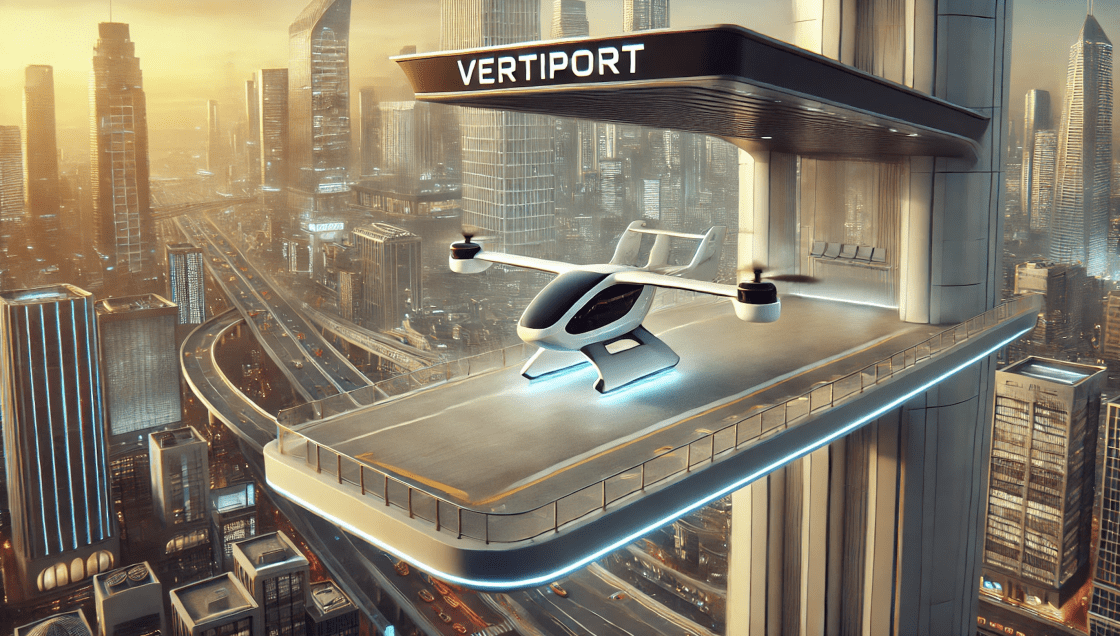The future of transportation is about to take off—literally. With the Federal Aviation Administration (FAA) finalizing its regulatory framework for air taxis, electric vertical take-off and landing (eVTOL) aircraft are set to become a reality in cities across the U.S. These electric flying vehicles, developed by companies like Joby Aviation and Archer Aviation, promise to revolutionize urban mobility by offering faster, more efficient, and eco-friendly commutes. This regulatory milestone is a critical step toward integrating air taxis into the National Airspace System (NAS), enabling them to operate safely and efficiently.
This blog will explore the FAA’s new regulations (PDF), the rise of the air taxi industry, and how this development will impact urban transportation. We’ll also break down the pros and cons of air taxis and discuss the potential challenges that remain. Whether you’re an industry insider, an executive, or a tech enthusiast, this comprehensive guide will provide the insight you need to understand the transformative potential of air taxis.
What Is an Air Taxi: Understanding eVTOL Technology
When people search for air taxis, they often want to know, “what exactly is an air taxi, and how does it work?” Simply put, air taxis are small, electric-powered aircraft capable of vertical takeoff and landing (VTOL). These aircraft are designed to navigate through urban environments without the need for long runways. Most eVTOLs use multiple rotors for lift and propulsion, making them quieter than helicopters and suitable for residential areas where noise pollution is a concern.
Key technical features of air taxis include:
- Electric propulsion systems: Air taxis are powered by electric batteries, making them more environmentally friendly than traditional fuel-powered aircraft.
- Multiple rotors: Instead of a single rotor like a helicopter, air taxis use several smaller rotors, allowing for more stable and quieter flight.
- VTOL capabilities: These vehicles can take off and land vertically, eliminating the need for runways and enabling them to operate from compact spaces like rooftops or designated “vertiports.”
eVTOL technology has been in development for over a decade, driven by advances in battery capacity, electric motor efficiency, and autonomous flight systems. With this technology, air taxis are poised to reduce travel times in congested urban areas, connecting city centers with airports and other key destinations in minutes.
FAA’s New Air Taxi Regulations: A Milestone for Urban Air Mobility
The release of FAA regulations is a pivotal moment for the air taxi industry. People often search for answers like “what are the new FAA rules for air taxis?” and “how do these regulations impact air taxi operations?” In October 2024, the FAA finalized its rules for powered-lift aircraft, the category that includes eVTOL vehicles, marking the first major regulatory framework for this new mode of transportation in nearly 80 years.
Key elements of the FAA’s regulations include:
- Pilot Certification: The FAA has created a specific pathway for air taxi pilot certification, outlining the requirements for flight training, simulator use, and supervised operational experience. These rules ensure that pilots operating air taxis have the necessary skills to handle these new, complex aircraft.
- Operational Standards: The FAA’s rules apply helicopter-like regulations to some phases of flight and fixed-wing aircraft standards to others. This hybrid approach accounts for the unique capabilities of eVTOLs, such as their vertical takeoff and landing abilities.
- Infrastructure Integration: The regulations provide guidance on integrating air taxis into the National Airspace System (NAS), focusing on safety protocols for operating in congested airspace. Initial operations will leverage existing infrastructure, such as heliports and public airports, but new “vertiports” will likely be needed as the industry scales.
By addressing safety, training, and operational standards, the FAA’s framework clears the way for air taxis to begin commercial operations, potentially by the end of 2025.
How Will Air Taxis Work in Cities: Urban Air Mobility (UAM) and Infrastructure Needs
One of the most common questions people ask when they hear about air taxis is, “how will air taxis operate in cities?” Air taxis are designed to function as part of an urban air mobility (UAM) system, providing short-distance travel across densely populated areas. In cities like New York, Los Angeles, and San Francisco, air taxis will initially operate between key points such as airports, central business districts, and transportation hubs.
However, the successful deployment of air taxis will require significant investment in infrastructure. Vertiports—dedicated landing and takeoff areas for air taxis—will need to be constructed in strategic locations. These vertiports will not only handle takeoff and landing operations but will also serve as charging stations for eVTOL aircraft, ensuring quick turnaround times for vehicles.
To meet urban air mobility needs, the following infrastructure developments will be critical:
- Vertiports: Similar to heliports but optimized for electric aircraft, vertiports will be distributed across urban areas to ensure efficient air taxi services.
- Charging Stations: Electric air taxis will require high-speed charging infrastructure at vertiports to minimize downtime between flights.
- Low-Altitude Air Traffic Management: As air taxis become more common, cities will need systems to manage low-altitude traffic, coordinating flights to avoid congestion and ensure safety.
These developments will transform urban landscapes, integrating air mobility into the fabric of city life. Governments and city planners need to collaborate to ensure cities are prepared for the infrastructure demands of this new transportation technology.
How Do Air Taxis Compare to Traditional Transportation
A key aspect of understanding air taxis is how they compare to existing modes of transport. Searches often revolve around “how are air taxis different from helicopters or planes?” and “what are the advantages of air taxis?” Let’s break down the differences:
- Noise Levels: Air taxis are significantly quieter than helicopters, thanks to their smaller, distributed rotors and electric propulsion systems. This makes them more suitable for urban environments where noise restrictions are a concern.
- Environmental Impact: Air taxis are fully electric, which means they produce zero emissions during flight. In contrast, helicopters and planes typically rely on fossil fuels, contributing to air pollution.
- Speed and Efficiency: While air taxis may not match the speed of airplanes over long distances, they offer substantial time savings for short urban trips, especially when factoring in road traffic. A flight across a city that might take 30 minutes by car could be reduced to just 10 minutes by air taxi.
- Cost: Initially, air taxis will be more expensive than other forms of transportation, but as battery technology improves and production scales up, prices are expected to come down, eventually competing with premium ride-sharing services like Uber Black.
What Are the Pros and Cons of Air Taxis
Executives and decision-makers often need a balanced view of new technologies. Searches like “what are the advantages and disadvantages of air taxis?” are common, especially as businesses evaluate the potential impact of this technology. Below is a comprehensive list of pros and cons:
Pros:
- Reduced Traffic Congestion: Air taxis can bypass gridlocked city streets, offering faster commutes and reducing road congestion.
- Environmental Benefits: As fully electric vehicles, air taxis produce zero emissions, making them a cleaner alternative to traditional forms of transportation.
- Time-Saving: By flying over traffic, air taxis significantly reduce travel times, especially for journeys between city centers and airports.
- Quieter Operation: Thanks to their electric motors and smaller rotors, air taxis generate less noise than helicopters, making them more suitable for urban areas.
- Investment Opportunities: With companies like Toyota, Stellantis, and Delta Airlines investing in air taxi technology, there are significant opportunities for early investors and partners in this space.
Cons:
- High Initial Costs: Early air taxi services will be priced at a premium, limiting access to higher-income individuals and corporate users in the beginning.
- Infrastructure Requirements: The need for vertiports, charging stations, and air traffic management systems will require significant investment from cities and private companies.
- Public Perception and Safety Concerns: Public trust will need to be earned, particularly around the safety and reliability of eVTOL aircraft in congested urban areas.
- Battery Limitations: Current battery technology limits the range of air taxis to about 100 miles per charge. As battery technology improves, so too will the operational efficiency of these vehicles.
- Regulatory Complexity: While the FAA has provided clarity for U.S. operations, companies will need to navigate different regulatory landscapes in other countries as they expand.
Air Taxi: the Future of Urban Transportation
The FAA’s approval of air taxi regulations is a monumental step toward realizing the future of urban air mobility. With commercial operations potentially beginning by 2025, the way we move through cities could change forever. However, challenges remain, particularly around infrastructure, public perception, and scalability.
As air taxis prepare for takeoff, the question remains: how quickly will cities adapt to this new technology, and are we ready to embrace flying vehicles as part of our everyday lives? Let us know your thoughts on the future of air taxis and how they could shape urban transportation.
Air Taxi Reads
Federal Aviation Administration
Fortune Article
Associated Press
The Washington Post
The Verge
Bloomberg
Reuters
Morning Brew


